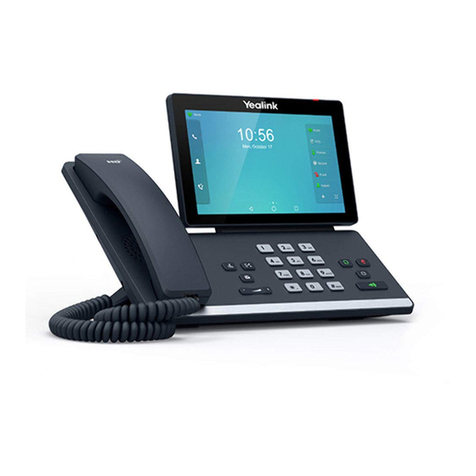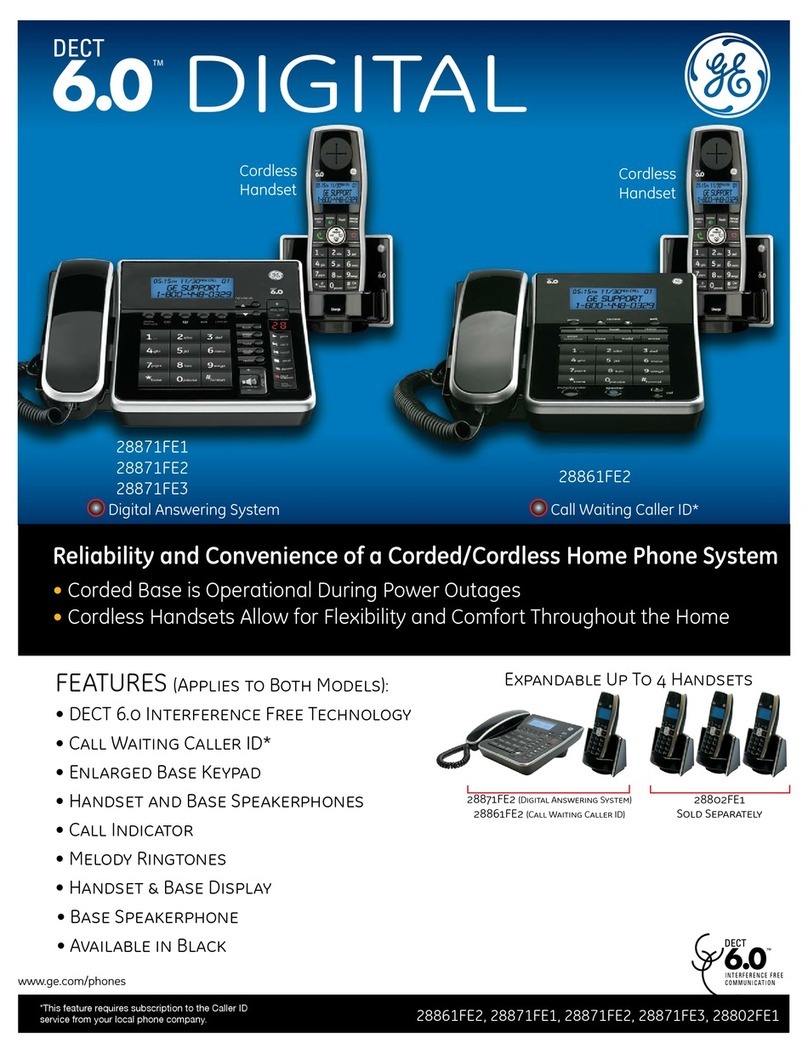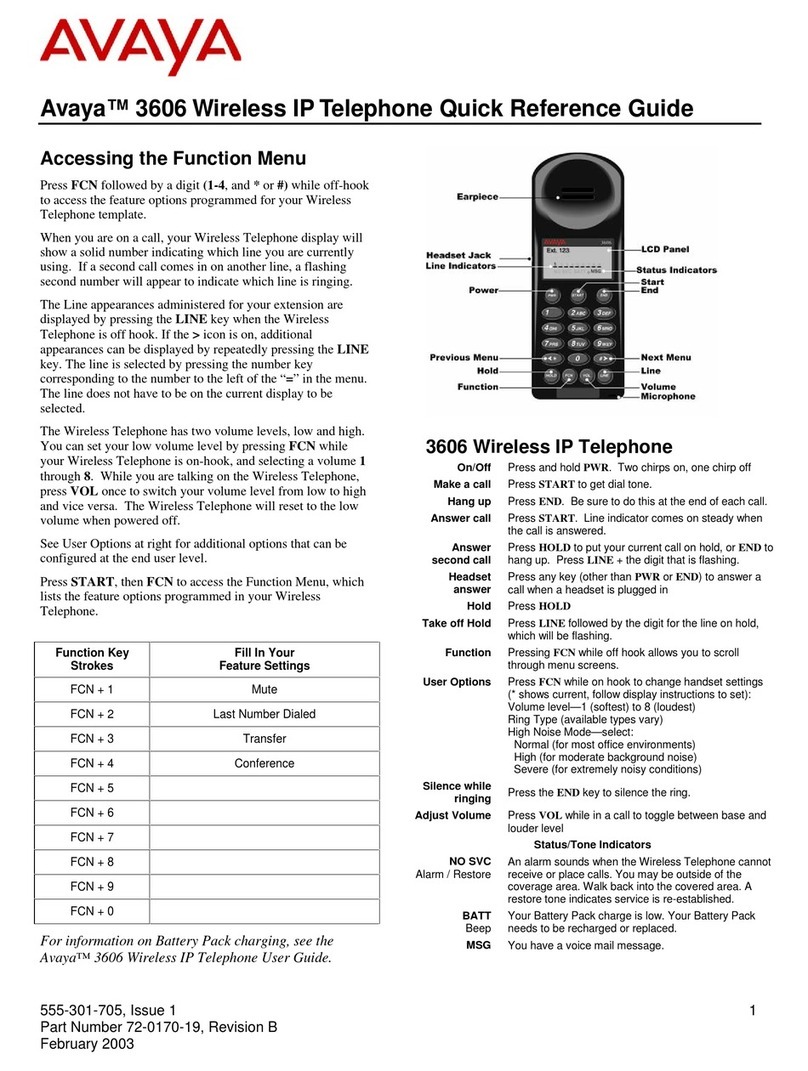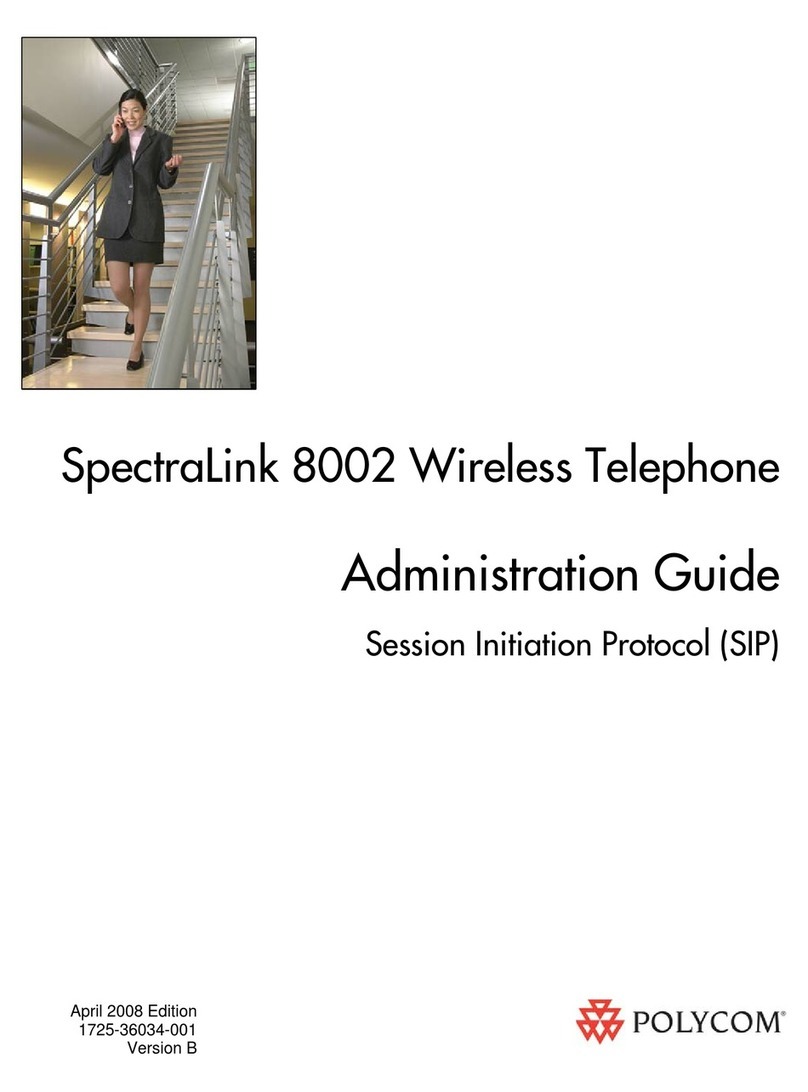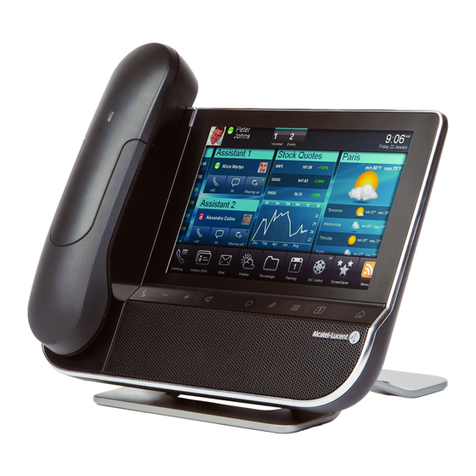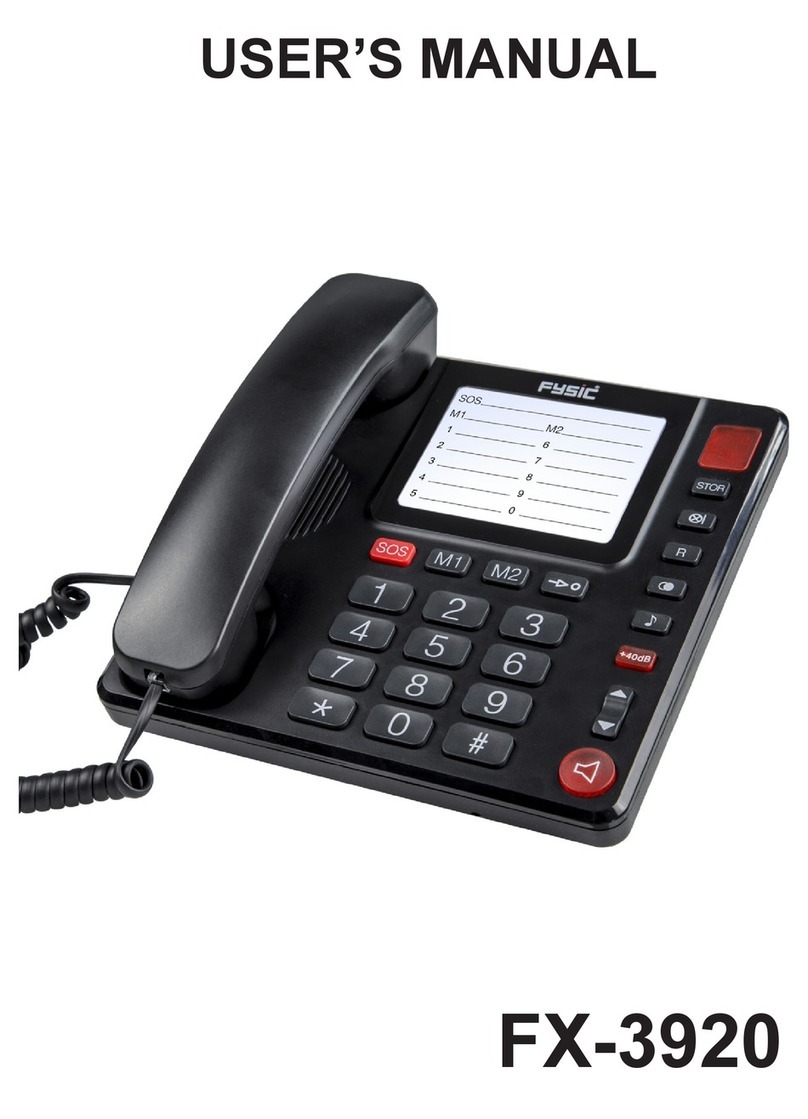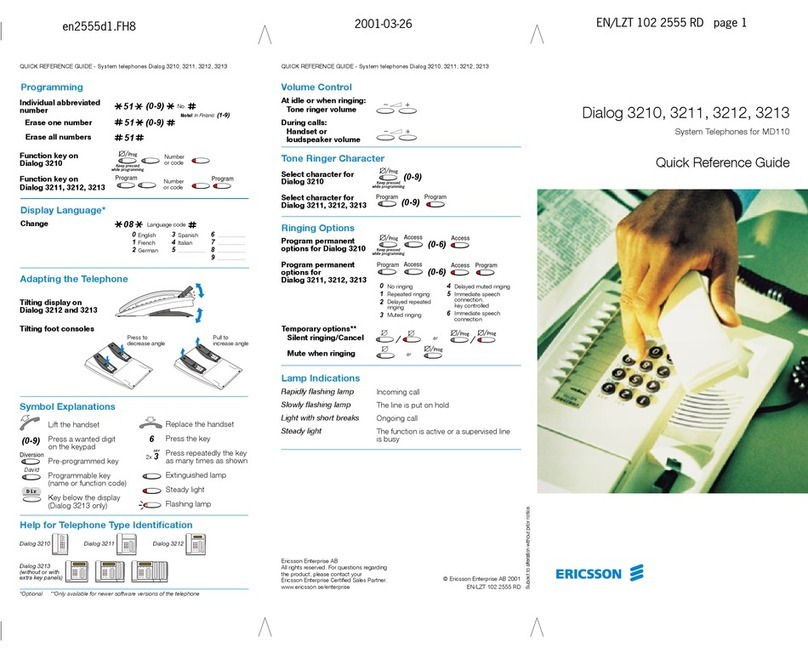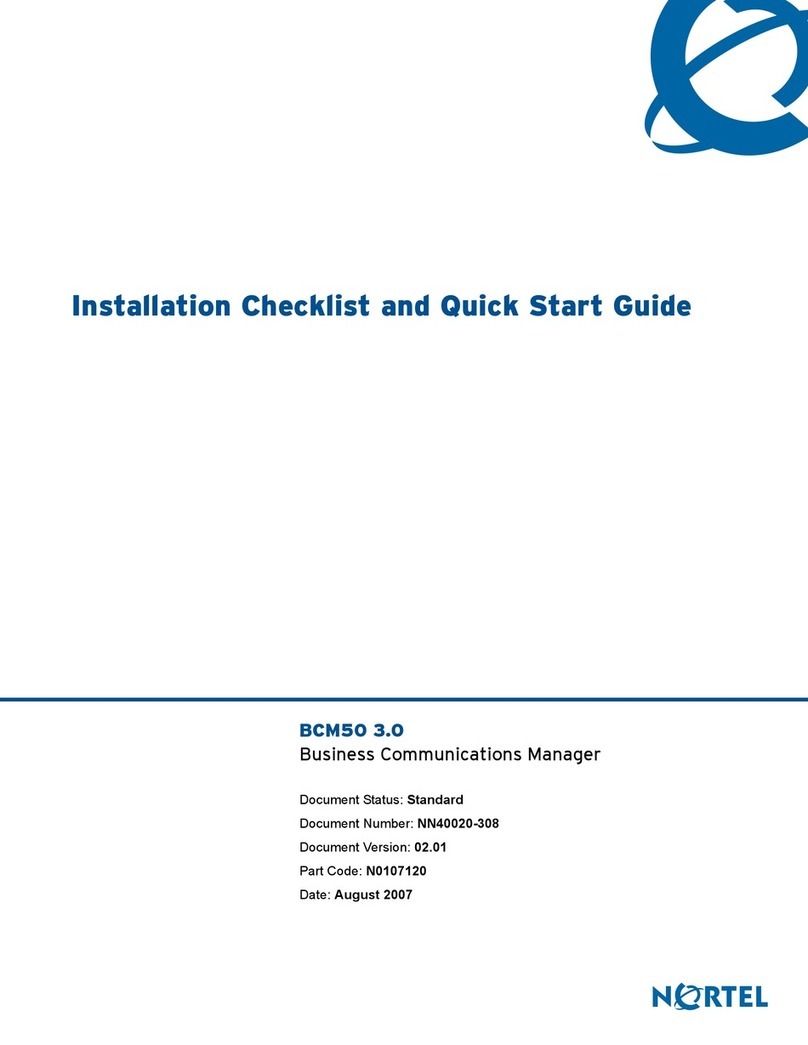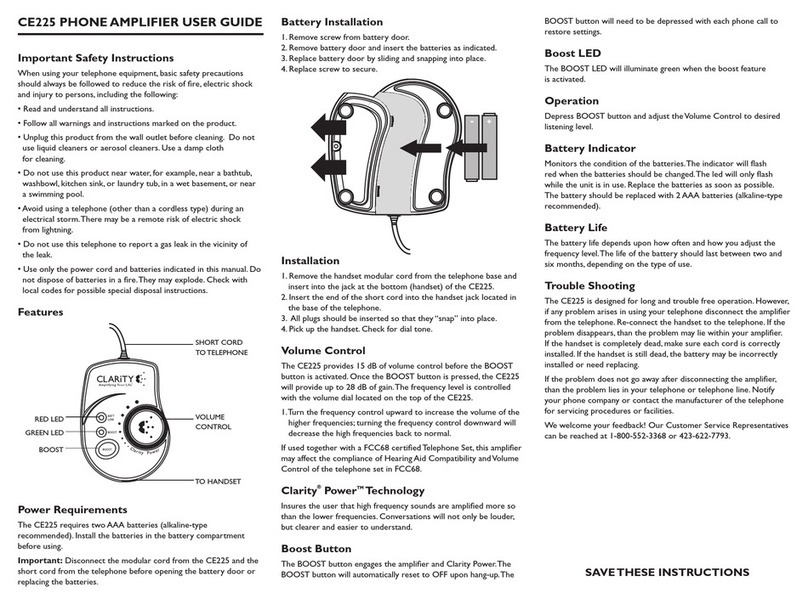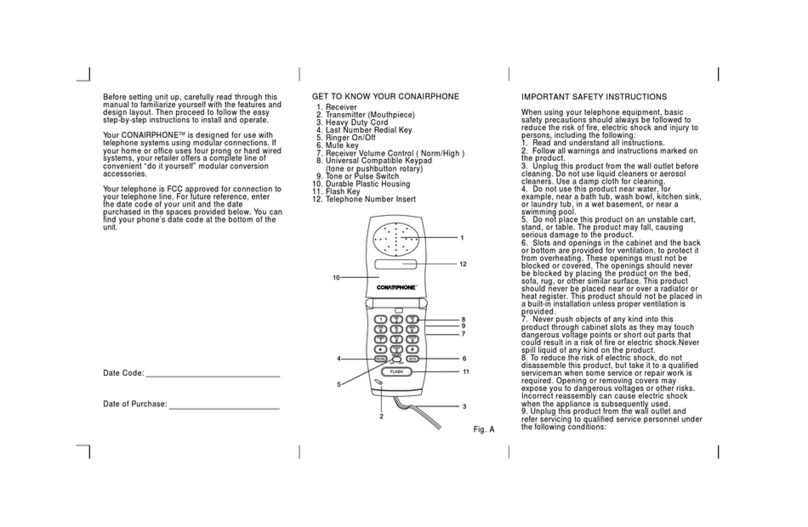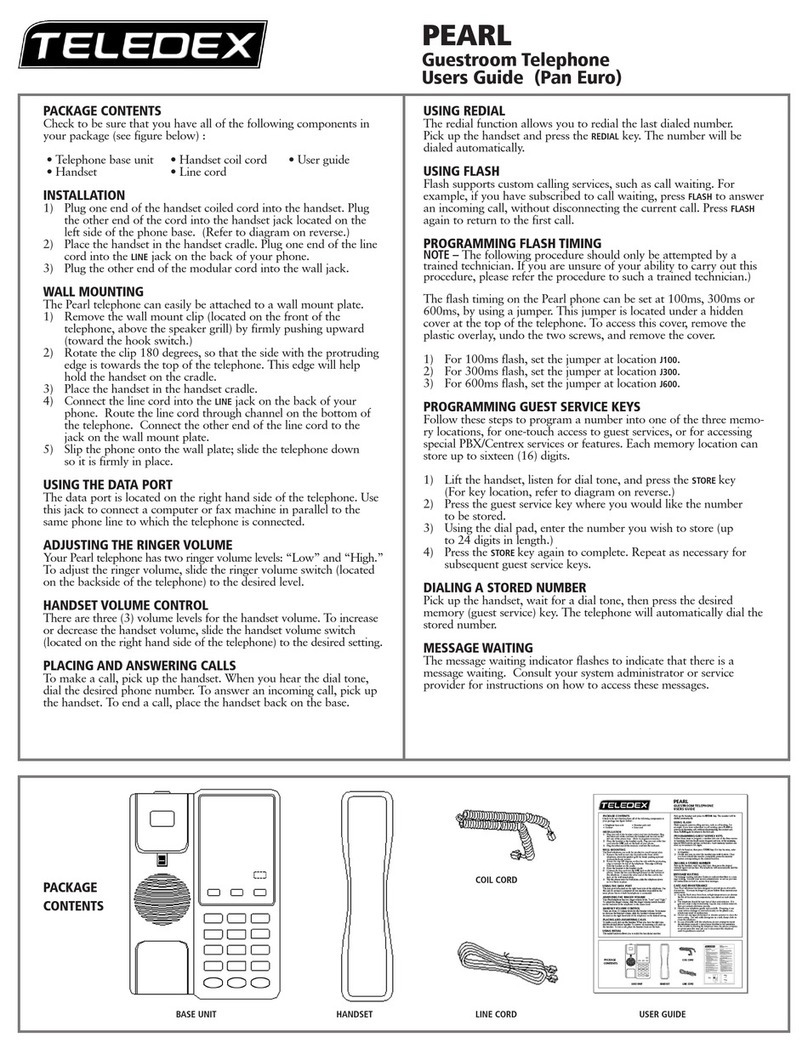elmeg C300 User manual

elmeg C300 - CS300
Version 2
1
G:\_elmeg\Ccs300\V2\UK\Bedienung\uk-300-mn-20x3.vp
Freitag, 20. September 2002 14:53:16
Farbprofil: Generic CMYK printer profile - None
Komposit Standardbildschirm

Important lnformation
These operating instructions describe the functions for the elmeg C300 ISDN tele-
phone and the elmeg CS300 system ISDN telephone.
Important notice for using the LCR procedure
This performance feature can currently be used in Germany only.
The rate tables for the LCR function of your telephone can
be obtained from TELEDATA-UPDATE Gesellschaft für
Telefon-Tarifdaten-Management mbH using a preset num-
ber in the product. ELMEG GmbH & Co. KG
Kommunikationstechnik cannot warrant that this tariff data
is up-to-date, complete and correct and declines any liabil-
ity resulting from the use of such data.
2
G:\_elmeg\Ccs300\V2\UK\Bedienung\uk-300-mn-20x3.vp
Freitag, 20. September 2002 14:53:16
Farbprofil: Generic CMYK printer profile - None
Komposit Standardbildschirm

Table of contents
1 Description . . . . . . . . . . . . . . . . . . . . . . . 1
1.1 Safety instructions. . . . . . . . . . . . . . . . . . . . . . . . . . . 1
1.2 Contents of package . . . . . . . . . . . . . . . . . . . . . . . . . 2
1.3 Cleaning and maintenance . . . . . . . . . . . . . . . . . . . . . . 2
1.4 Placing the telephone . . . . . . . . . . . . . . . . . . . . . . . . . 2
1.5 User interface of your system telephone . . . . . . . . . . . . . . . 3
1.6 Display, Buttons, LEDs, Call signalling, Pictographs and signals . . . 4
1.7 Additional information in the display . . . . . . . . . . . . . . . . . 10
2 Installation of the telephone . . . . . . . . . . . . . 11
2.1 Connection of the handset connecting cord. . . . . . . . . . . . . 11
2.2 Connection of the ISDN connecting cord . . . . . . . . . . . . . . 11
2.3 Connection of the telephone to the PC . . . . . . . . . . . . . . . 12
2.4 Changing the label panel. . . . . . . . . . . . . . . . . . . . . . . 13
2.5 Keyboard extension elmeg T300. . . . . . . . . . . . . . . . . . . 14
3 Settings . . . . . . . . . . . . . . . . . . . . . . . . 17
3.1 Telephone numbers (MSN or extension number) . . . . . . . . . . 17
3.2 Volume settings . . . . . . . . . . . . . . . . . . . . . . . . . . . 22
3.3 Call forwarding (call rerouting) . . . . . . . . . . . . . . . . . . . . 26
3.4 Call waiting . . . . . . . . . . . . . . . . . . . . . . . . . . . . . . 28
3.5 Setting appointment . . . . . . . . . . . . . . . . . . . . . . . . . 29
3.6 Call Filter . . . . . . . . . . . . . . . . . . . . . . . . . . . . . . . 30
3.7 Setting the date and time . . . . . . . . . . . . . . . . . . . . . . 33
3.8 Setting the User Interface . . . . . . . . . . . . . . . . . . . . . . 33
3.9 Direct dialing . . . . . . . . . . . . . . . . . . . . . . . . . . . . . 35
3.10 Displays of the telephone . . . . . . . . . . . . . . . . . . . . . . 38
3.11 Call control . . . . . . . . . . . . . . . . . . . . . . . . . . . . . . 43
3.12 Protecting the configuration by a PIN (password). . . . . . . . . . 46
3.13 Call charges . . . . . . . . . . . . . . . . . . . . . . . . . . . . . 47
3.14 Least Cost Routing (LCR) . . . . . . . . . . . . . . . . . . . . . . 50
3.15 Setting the default park code . . . . . . . . . . . . . . . . . . . . 53
3
G:\_elmeg\Ccs300\V2\UK\Bedienung\uk-300-mn-20x3.vp
Freitag, 20. September 2002 14:53:16
Farbprofil: Generic CMYK printer profile - None
Komposit Standardbildschirm

3.16 Assigning a name . . . . . . . . . . . . . . . . . . . . . . . . . . 53
3.17 Emergency operation . . . . . . . . . . . . . . . . . . . . . . . . 54
3.18 Programming the phone directory . . . . . . . . . . . . . . . . . . 56
3.19 Programming VIP numbers . . . . . . . . . . . . . . . . . . . . . 60
3.20 Programming direct dialing numbers . . . . . . . . . . . . . . . . 61
3.21 Programming macro functions (only for CS300) . . . . . . . . . . . 66
3.22 Programming the elmeg T300 keyboard extension . . . . . . . . . 72
4 Settings for a PABX system . . . . . . . . . . . . . 75
4.1 Number length . . . . . . . . . . . . . . . . . . . . . . . . . . . . 75
4.2 Automatic exchange line acquisition (only for C300) . . . . . . . . 75
4.3 Line access digit (LAD) . . . . . . . . . . . . . . . . . . . . . . . . 76
4.4 Setting the PABX system type . . . . . . . . . . . . . . . . . . . . 76
4.5 Emergency operation at a point-to-point connection . . . . . . . . 77
4.6 Function keys at elmeg pabx systems (only for CS300) . . . . . . . 78
4.7 System menu for elmeg PABX systems (only for CS300) . . . . . . 85
5 Operation . . . . . . . . . . . . . . . . . . . . . . . 87
5.1 Starting a call . . . . . . . . . . . . . . . . . . . . . . . . . . . . 87
5.2 Accepting a call . . . . . . . . . . . . . . . . . . . . . . . . . . . 89
5.3 »Station guarding« . . . . . . . . . . . . . . . . . . . . . . . . . . 90
5.4 Rejecting / rerouting a call . . . . . . . . . . . . . . . . . . . . . . 90
5.5 Redialing . . . . . . . . . . . . . . . . . . . . . . . . . . . . . . . 91
5.6 Caller and memo list . . . . . . . . . . . . . . . . . . . . . . . . . 94
5.7 Mute, Open Listening and Hands-Free Calling . . . . . . . . . . . 98
5.8 Light Telephone Headset (Headset) . . . . . . . . . . . . . . . . . 99
5.9 Message and Intercom (CS300 only) . . . . . . . . . . . . . . . . 100
5.10 User-defined text messages ( CS300 only) . . . . . . . . . . . . . 101
5.11 Call waiting, Enquiry call, Broker`s call and
three-party conference . . . . . . . . . . . . . . . . . . . . . . . 105
5.12 Call transfer (switching) . . . . . . . . . . . . . . . . . . . . . . . 106
5.13 Parking . . . . . . . . . . . . . . . . . . . . . . . . . . . . . . . 107
5.14 Call-Back on busy (CCBS) . . . . . . . . . . . . . . . . . . . . . 107
5.15 Malicious call identification (MCID) . . . . . . . . . . . . . . . . . 108
5.16 Keypad and tone frequency dialing (DTMF dialing). . . . . . . . . 109
5.17 Viewing and deleting call charges . . . . . . . . . . . . . . . . . 110
5.18 CTI with TAPI . . . . . . . . . . . . . . . . . . . . . . . . . . . . 112
4
G:\_elmeg\Ccs300\V2\UK\Bedienung\uk-300-mn-20x3.vp
Freitag, 20. September 2002 14:53:17
Farbprofil: Generic CMYK printer profile - None
Komposit Standardbildschirm

6 Service functions . . . . . . . . . . . . . . . . . . 113
6.1 Read firmware version of the telephone . . . . . . . . . . . . . . 113
6.2 Country-specific settings . . . . . . . . . . . . . . . . . . . . . . 113
6.3 Downloading a new firmware . . . . . . . . . . . . . . . . . . . . 114
6.4 Telephone BIOS . . . . . . . . . . . . . . . . . . . . . . . . . . 116
6.5 Resetting to default state . . . . . . . . . . . . . . . . . . . . . . 117
7 Telephone and PC . . . . . . . . . . . . . . . . . . 118
7.1 Contents of the CD-ROM . . . . . . . . . . . . . . . . . . . . . . 118
7.2 Installing the programs from CD-ROM . . . . . . . . . . . . . . . 120
8 Technical specifications. . . . . . . . . . . . . . . 123
9 Declaration of conformity . . . . . . . . . . . . . . 124
10 Index . . . . . . . . . . . . . . . . . . . . . . . . . 125
5
G:\_elmeg\Ccs300\V2\UK\Bedienung\uk-300-mn-20x3.vp
Freitag, 20. September 2002 14:53:17
Farbprofil: Generic CMYK printer profile - None
Komposit Standardbildschirm

6
G:\_elmeg\Ccs300\V2\UK\Bedienung\uk-300-mn-20x3.vp
Freitag, 20. September 2002 14:53:17
Farbprofil: Generic CMYK printer profile - None
Komposit Standardbildschirm

1 Description
These operating instructions describe the functions for both elmeg C300 and el-
meg CS300 ISDN telephones.
You can connect the ISDN telephone at the Euro-ISDN point-to-point connection
(DSS1 protocol) provided by your network service provider, or at the internal ISDN con-
nection (point-to-point connection DSS1 protocol) in a PABX system. The ISDN tele-
phone is linked to the ISDN network via an ISDN jack (Western or RJ45). After being con-
nected to the ISDN network, your ISDN telephone is immediately ready for operation
and can fully utilize its configured performance features.
Up to eight (8) ISDN terminal devices can be connected and managed at a network ter-
mination of a network service provider. Of these eight (8) available lines, one supply line
(max. 4 W) is available for ISDN telephones without their own internal power supply. A
link can be set up simultaneously for two (2) ISDN terminal devices at each base access
terminal (2 B channels, 1 D channel).
An internal ISDN connection for a PABX system is comparable to an ISDN base access
terminal (point-to-point connection) of a network service provider. Up to eight (8) ISDN
terminal devices can be connected and managed at each internal ISDN connection. The
power available at this internal ISDN connection determines how many terminal devices
can be supplied with power by the PABX system. Refer to the operating instructions for
your PABX, or contact the PABX manufacturer for more details about this. A link can be
set up simultaneously for two (2) ISDN terminal devices at each internal ISDN connecti-
on.
The elmeg CS300 ISDN telephone provides system features when connected to certain
elmeg PABX systems. The internal connection (S0 bus) on these PABX systems auto-
matically interfaces with the elmeg CS300 ISDN telephone. Please refer to the operating
instructions of your PABX to determine whether these typical system performance fea-
tures are provided with the various elmeg telephones.
The typical system performance features described in these operating instructions
apply only to the elmeg CS 300 ISDN telephone, and not to the elmeg C300 ISDN
telephone.
1.1 Safety instructions
•Unauthorized opening of the telephone and improper repairs may result
in risk of injury for the user.
•Do not expose the inside of the telephone to any liquids. This would pose
a risk of electrical shock If you expose the inside of the telephone to liquids
the telephone can be destroyed.
•You should not connect or disconnect any lines during thunderstorms.
•To prevent mutual interference, do not install your system telephone in the
immediate vicinity of electronic devices such as stereo equipment, elec-
tric office equipment or microwave units.
1
Description
7
G:\_elmeg\Ccs300\V2\UK\Bedienung\uk-300-mn-20x3.vp
Freitag, 20. September 2002 14:53:17
Farbprofil: Generic CMYK printer profile - None
Komposit Standardbildschirm

•Avoid installing near sources of excessive heat, e.g. radiators or in rooms
with excessive humidity.
The ambient temperature must not be below 5° and should not exceed
40°C.
1.2 Contents of package
•ISDN system telephone elmeg C300 or
ISDN system telephone elmeg CS300
•handset with handset connecting cord
•ISDN connecting cord (approx. 3m)
•PC connecting cable (RS232/V.24)
RJ12 / D-SUB 9-pin (approx. 3m)
•operating instruction
•Label for direct dialing/function keys
•elmeg WIN-Tools CD-ROM with: detailed operating instruction;> confi-
guration manager, telephone directory manager, download and LCR ma-
nager, sound manager;
TAPI driver and TAPI application:Adobe Acrobat file
for the printing of individual labels
•Firmware for the telephone
1.3 Cleaning and maintenance
The ISDN system telephone has been manufactured for normal, everyday use. When re-
quired, clean the ISDN system telephone with a slightly moistened cloth, or with an
anti-static cloth. Never use a solvent to clean the phone! Never use a dry cloth. Electro-
static charges could damage the electronics in the system. It is essential that no liquids
penetrate into the inside of the ISDN system telephone, as this could destroy the phone.
1.4 Placing the telephone
Please note that the plastic feet of your ISDN system telephone may leave marks on sen-
sitive surfaces, such as furniture. The manufacturer of the ISDN system telephone is not
liable for any such damage. Therefore, use appropriate non-skidding pads under the
phone.
2
Description
8
G:\_elmeg\Ccs300\V2\UK\Bedienung\uk-300-mn-20x3.vp
Freitag, 20. September 2002 14:53:17
Farbprofil: Generic CMYK printer profile - None
Komposit Standardbildschirm

1.5 User interface of your system telephone
3
Description
1
FESC C
OK
18
3
123L
456T
789W
*0#R
1
2
3
4
5 Display
6 4 softkeys
7
8
9 Escape
Speaker
Label panel for VIP keys and
function keys
7 direct dialing/ function keys
with LED
Shift button with LED
Microphone
Function key
10
11
12
13
14
15
16
17
18
C-button
Acknowledgement
Arrow buttons »left« / »right«
Open listening/ hands-free
Disconnect
Redial
Enquiry
Asterix button / number symbol
Dial / VIP buttons
2
1
4
13.04.01 13:55 }
tbook vip quiet
12
11
10 9
87
6
5
13
14
15
16
17
Fig. 1
9
G:\_elmeg\Ccs300\V2\UK\Bedienung\uk-300-mn-20x3.vp
Freitag, 20. September 2002 14:53:23
Farbprofil: Generic CMYK printer profile - None
Komposit Standardbildschirm

1.6 Display, Buttons, LEDs, Call signalling, Pictographs
and signals
1.6.1 Display
After you connect the system to the ISDN connection,
the date and time are shown on the top line of the dis-
play. The date and time are imported automatically
from the PABX system, or from the ISDN network
when you have successfully made a call. Terms are
displayed in capital and small letters on the first line.
The functions of the softkeys are displayed in capital
or small letters (depending on your settings) in the se-
cond line.
ˆ13.04.01 13:55 }
ˆtbook vip quiet
The text displayed for a function on line 2 is always lo-
cated above the corresponding softkey. When you
press the softkey, the next level is displayed.
ˆ Functions
ˆaudib adjust prog config
SSSS
1.6.2 Buttons
FFunction button: This key opens the pro-
gramming menu. If you are already loca-
ted in a menu and then press the key, eit-
her menu-specific functions are shown, or
you are moved back one programming
step.
ˆ Functions
ˆaudib adjust prog config
EEscapebutton: Pressingthe Escbutton during programmingreturns thetele-
phone to its idle status.
OOK key: Pressing this button stores a setting in the telephone. You then hear
the acknowledgement signal.
4
Description
Date
Arrow: further menu items
accessible with arrow buttons
13.04.01 13:55 }
tbook vip quiet
24 chars
Time
1st line
2nd line
Text assignment to softkey
4 softkeys SSSS
Fig. 2
10
G:\_elmeg\Ccs300\V2\UK\Bedienung\uk-300-mn-20x3.vp
Freitag, 20. September 2002 14:53:28
Farbprofil: Generic CMYK printer profile - None
Komposit Standardbildschirm

CC-button: Press this button to move back one menu step in the menu. If you
are currently in the input mode, this button can be used to delete individual
characters.
<> Arrow buttons: The arrows »{« and »}«in
the right corner on the top line of the dis-
play indicate that you can call up further
functions on the lower lines using the ar-
row buttons.
ˆ13.04.01 13:55 }
ˆ vip quiet
ˆ13.04.01 13:55 {}
ˆunpark rate
If not all information fit into the screen, this will be indicated by »««or»»«. To view the
other characters, first press the Shift button, followed by the arrow keys.
Special feature for changing existing entries
You have various options available to you for changing existing entries (e.g. names or
numbers).
Example 1:
You wish to change an existing number / MSN (see page 18), as the telephone is to be
used at a different ISDN connection.
tWhen you use the pushbutton set to enter
the first digit of the new number the exi-
sting number is deleted completely.
ˆ Program dial number
ˆMSN1>123456
ˆ Program dial number
ˆMSN1>9_
tEnter the other digits of the new number. ˆ Program dial number
ˆMSN1>987654_
Example 2:
You wish to change parts of a name in a telephone directory listing (see page 57).
<>
C
Using the arrow keys, first select the let-
ters of the entry that are to be changed (in
this example the surname »Miller«) and
delete the name using the C button.
ˆChange tbook data input
ˆname>TINA MILLER_
ˆ Change tbook data input
ˆName>TINA _
5
Description
11
G:\_elmeg\Ccs300\V2\UK\Bedienung\uk-300-mn-20x3.vp
Freitag, 20. September 2002 14:53:28
Farbprofil: Generic CMYK printer profile - None
Komposit Standardbildschirm

tNow enter the new letters for the new
name (in the example the surname »PE-
TERS«).
ˆ Change tbook data input
ˆName>TINA PETERS_
1.6.3 Entering letters and numbers
The following buttons are configured for the entry of letters and numbers (e.g. Telepho-
ne directory, VIP memory, UUS1); the keys are assigned as follows:
Button 1.
press 2.
press 3.
press 4.
press 5.
press 6.
press 7.
press
11
2ABC2Ä
3DEF 3
4GHI 4
5JKL5
6MNO6 Ö
7PQRS7ß
8TUV8Ü
9WX Y Z 9
0(space) . , - 0 / &
**
##
6
Description
12
G:\_elmeg\Ccs300\V2\UK\Bedienung\uk-300-mn-20x3.vp
Freitag, 20. September 2002 14:53:29
Farbprofil: Generic CMYK printer profile - None
Komposit Standardbildschirm

You have various possibilities for entering letters:
»« •Every letter that you enter is shown in small case.
Example: »tony miller«.
»ABC«•Every letter that you enter is shown as capitals.
Example: »TONY MILLER«.
»Abc«•The next letter that you enter is shown as a capital, all others as small case
letters. Example:»Tony Miller«.
Use the Shift key to set how you wish to enter characters. The selected input mode is
shown on the right on the first line of the display » «, »ABC« or »Abc«.
1.6.4 LEDs
To the left of each direct dialing and function key (total of 7) is located the associated
LED. These LEDs can be used to indicate certain functions. The shift key LED flashes to
indicate new callers in the caller list, or remains lit when the shift key is pressed (active).
•The LED lights up.
///////////////////////////////////////////
•The LED flashes.
////////////____////////////____///////////
•The LED flickers.
//__//__//__//__//__//__//__//__//__//__//_
1 second 1 second 1 second 1 second
1.6.5 Call signaling
Call signaling is effected using the ringing tone that has been set for the dialed number
(MSN) in each telephone. If you are using the telephone at an internal ISDN connection of
certain elmeg PABX systems, you can program special ringing melodies and volumes
for internal and external calls.
7
Description
13
G:\_elmeg\Ccs300\V2\UK\Bedienung\uk-300-mn-20x3.vp
Freitag, 20. September 2002 14:53:29
Farbprofil: Generic CMYK printer profile - None
Komposit Standardbildschirm

1.6.6 Pictographs
The pictographs (symbols) described in the following have been used in these operating
instructions to illustrate some procedures for setting and using the telephone.
bLift up the handset, activate hands free calling, or start initializing se-
lection.
aHang up the handset and end hands free calling.
The telephone is idle.
lA call is signaled.
The ringing tone melody sounds.
gYou are conducting a call.
dA three-party conference call is initiated.
qYou hear the positive or negative acknowledgement signal.
tSelect the number, code, character or text.
0...9
*#
Press the appropriate button on the pushbutton set.
8
Description
14
G:\_elmeg\Ccs300\V2\UK\Bedienung\uk-300-mn-20x3.vp
Freitag, 20. September 2002 14:53:29
Farbprofil: Generic CMYK printer profile - None
Komposit Standardbildschirm

1.6.7 Listen to acknowledgment signals
Depending on your settings, the input you make at your phone will be confirmed by an
acknowledgment signal (see page 23)
Before you begin making settings, you should listen to these two acknowledgment sig-
nals of your telephone.
Positive acknowledgment signal
The positive acknowledgment signal indicates that your input has been accepted and
stored by the telephone.
aSS
q
quiet no
Negative acknowledgment signal
You will hear the negative acknowledgment signal when your input has not been accep-
ted by the telephone, or when invalid input has been made.
a>SO
q
unpark
If no call is parked you hear the negative acknowledgment signal.
9
Description
15
G:\_elmeg\Ccs300\V2\UK\Bedienung\uk-300-mn-20x3.vp
Freitag, 20. September 2002 14:53:29
Farbprofil: Generic CMYK printer profile - None
Komposit Standardbildschirm

1.7 Additional information in the display
When the telephone is in the idle state, additional in-
formation about functions/performance features that
have been configured are shown on the top line of the
display. In the example: »DVqC«.
ˆ13.04.01 13:55 DVqC }
ˆtbook vip quiet
>S To obtain further information about set
functions press the right arrow button and
then the softkey below »info«.
If several functions have been set, press
the arrow button or the softkey below
»info«, to view the various settings.
ˆ13.04.01 13:55 DVqC {}
ˆunpark charges info
ˆCall forwarding direct{}
ˆ(1}0123456789) info
Displays Configured function
»D«Active date set
»V«Dial control, call filter or configuration protection active
»q«Function “Station guarding” (only brief signal) active
»Q«Function “Station guarding” (complete) active
»C«call forwarding active
10
Description
16
G:\_elmeg\Ccs300\V2\UK\Bedienung\uk-300-mn-20x3.vp
Freitag, 20. September 2002 14:53:29
Farbprofil: Generic CMYK printer profile - None
Komposit Standardbildschirm

2 Installation of the telephone
2.1 Connection of the handset connecting cord
Connect the handset cord as shown in figure 3. Lay the handset cord in the cord groove
and lock it below the two cord retainers.
2.2 Connection of the ISDN connecting cord
Connect the ISDN cord as shown in figure 4. Then lay the ISDN cord in the cord groove
and lock it below the two cord retainers. Ensure that the longer ISDN connector is plug-
ged into the ISDN jack and the shorter ISDN connector into the ISDN jack on the tele-
phone.
11
Installation
Handset
Handset cord
Telephone seen from the bottom
Handset
connector
Jack for
connecting
the handset
Handset jack
Cord holder
Fig. 3
ISDN connector
(long)
Jack for ISDN connectin
g
cord
Cord holder
ISDN connector
(short)
Telephone seen from the bottom
Fig. 4
17
G:\_elmeg\Ccs300\V2\UK\Bedienung\uk-300-mn-20x3.vp
Freitag, 20. September 2002 14:53:41
Farbprofil: Generic CMYK printer profile - None
Komposit Standardbildschirm

2.3 Connection of the telephone to the PC
Connect the PC cable as shown in figure 5. Plug the RJ12 connector into the RJ12 jack
on the back of the telephone and the 9-pin D-SUB connector onto the corresponding
connecting jack of your PC.
Only use the PC cable delivered with the system, as this is not a standard serial ca-
ble.
Allocation of the PC cable (RS232/V.24)
12
Installation
Telephone seen from the back
Jack(RJ12) for connecting
the RS232(V.24) cable
RS232(V.24) connector
(D-SUB 9 poles)
RS232(V.24) connector
(RJ12)
Fig. 5
RJ12 connector
(6 poles)
RS 232(V.24) connector
(9 poles)
2
3
5
6
7
8
4
1
9
3
4
6
1
2
5
Fig. 6
18
G:\_elmeg\Ccs300\V2\UK\Bedienung\uk-300-mn-20x3.vp
Freitag, 20. September 2002 14:53:52
Farbprofil: Generic CMYK printer profile - None
Komposit Standardbildschirm

2.4 Changing the label panel
The label panels for the direct dial and function keys are included on a sheet enclosed in
the operating instructions. Cut out the label you wish to use and ensure that all the holes
for the LEDs have been punched out completely. Where required, remove any remai-
ning material from the holes.
To change the label panel (see figure 7), press the flexible cover together between your
index finger and thumb and lift it out. The label panel can now be changed.
You can fill in the label panel via your PC yourself. The CD ROM supplied with the system
contains an Adobe Acrobat file with templates.
Move the mouse pointer to the first field (behind the symbol »(«). You can then use the
PC keyboard to make input into this field. You can jump from field to field using the TAB
key and fill them in as required. After this you can print out a selected label panel, cut it
out and place it in the space provided for labels on your telephone.
13
Installation
Fig. 7
19
G:\_elmeg\Ccs300\V2\UK\Bedienung\uk-300-mn-20x3.vp
Freitag, 20. September 2002 14:53:58
Farbprofil: Generic CMYK printer profile - None
Komposit Standardbildschirm

2.5 Keyboard extension elmeg T300
Your telephone is equipped with 7 direct dialing buttons which can be assigned various
functions on two levels. A key extension module (elmeg T300) can also be connected to
the elmeg C300 and elmeg CS300 telephones. This key extension module has 24 but-
tons which can be used on two levels as function or direct dialing buttons.
The elmeg T300 key extension module is available as an accessory for the elmeg
C300 and elmeg CS300 phones. Ask your specialized dealer or distributor.
2.5.1 Connection of the elmeg keyboard extension
•Unplug the ISDN connector (long) for the telephone from the ISDN jack.
•Place the phone face-down on a soft surface so that you can read the na-
meplate on the bottom of the phone from the front.
•Remove the screw to the left of the nameplate, the top left rubber support
and the plastic cover in the top left corner of the phone (see figure 8).
•Place the key extension module with its front side next to the phone on the
left so that the expandable catches fit in the retainer for the rubber supp-
orts.
•Secure the key extension module to the phone. To do this, screw in and
tighten one screw to the left of the nameplate and the other one in the ex-
pandable catch.
•Connect the connecting cable delivered with the key extension module as
shown in figure 9 . After this, place the cable in the cable duct.
14
Installation
Telephone seen from the
bottom
Fastening screw
Cover
Foot
Fastening
Keyboard extension,
seen from the bottom
Keyboard extension,
seen from the bottom
Fig. 8
20
G:\_elmeg\Ccs300\V2\UK\Bedienung\uk-300-mn-20x3.vp
Freitag, 20. September 2002 14:54:03
Farbprofil: Generic CMYK printer profile - None
Komposit Standardbildschirm
Other manuals for C300
1
This manual suits for next models
1
Table of contents
Other elmeg Telephone manuals

elmeg
elmeg C310 User manual
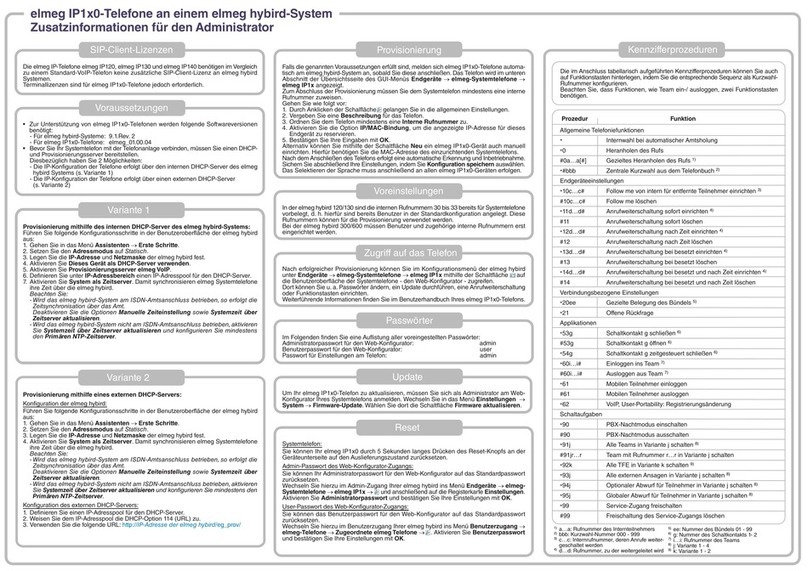
elmeg
elmeg IP120 Installation manual

elmeg
elmeg IP290 User manual

elmeg
elmeg C300 User manual
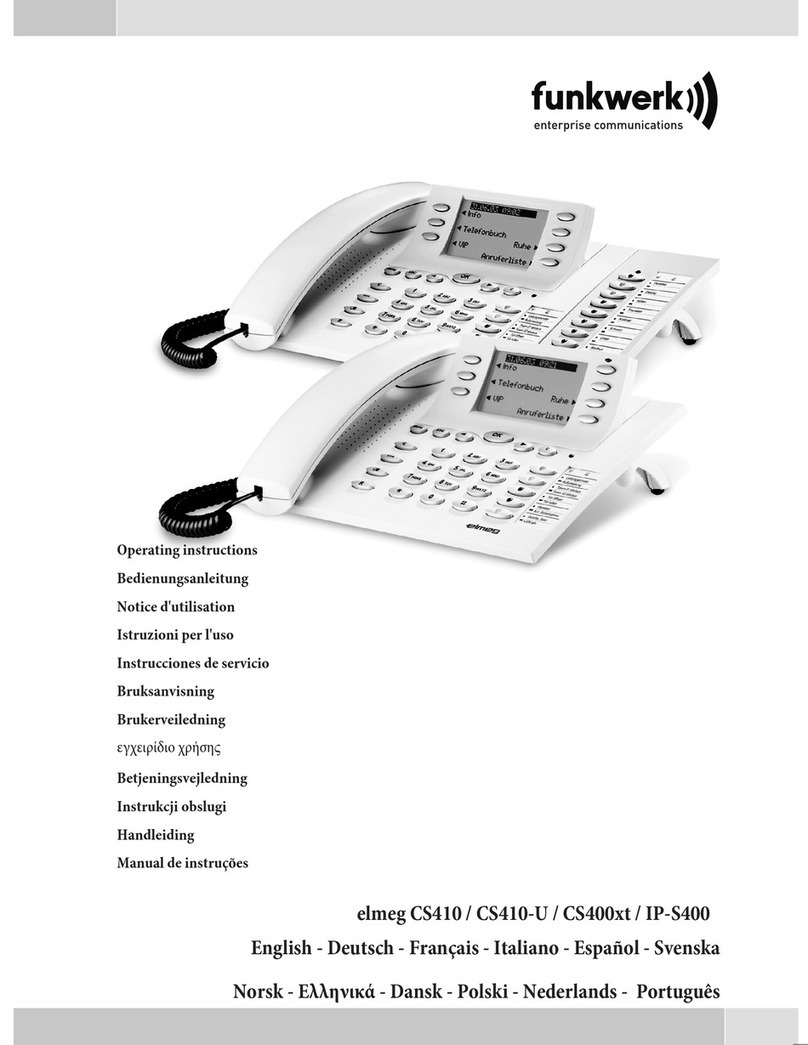
elmeg
elmeg CS410 User manual
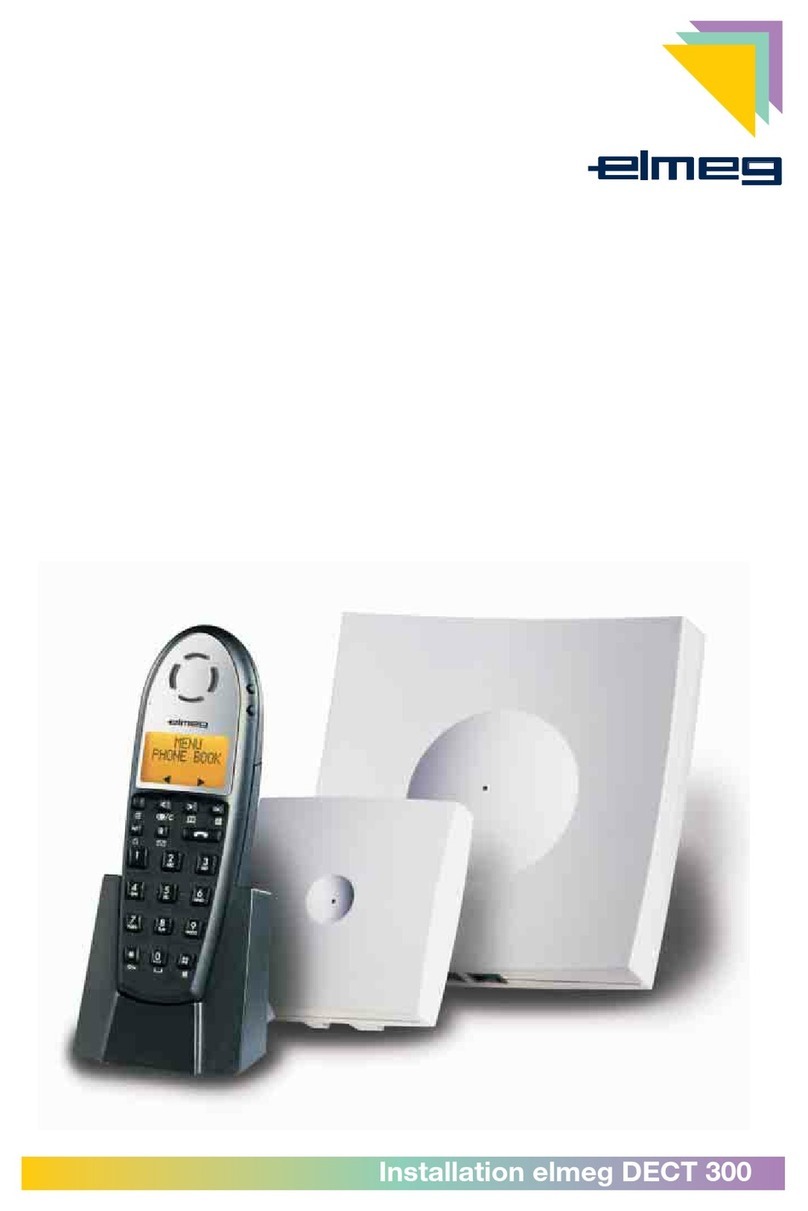
elmeg
elmeg DECT 300 User manual
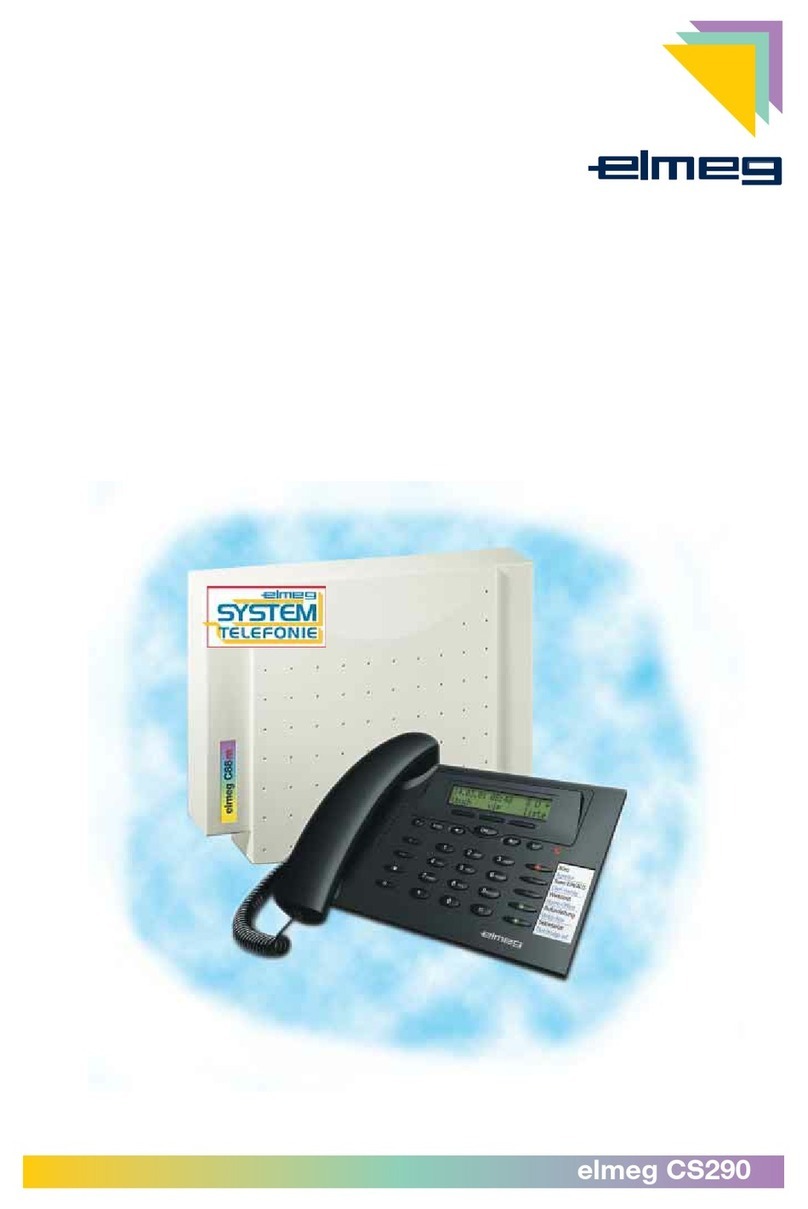
elmeg
elmeg CS290 User manual

elmeg
elmeg C46e Operating and installation instructions

elmeg
elmeg CS290 User manual

elmeg
elmeg CS410 User manual

